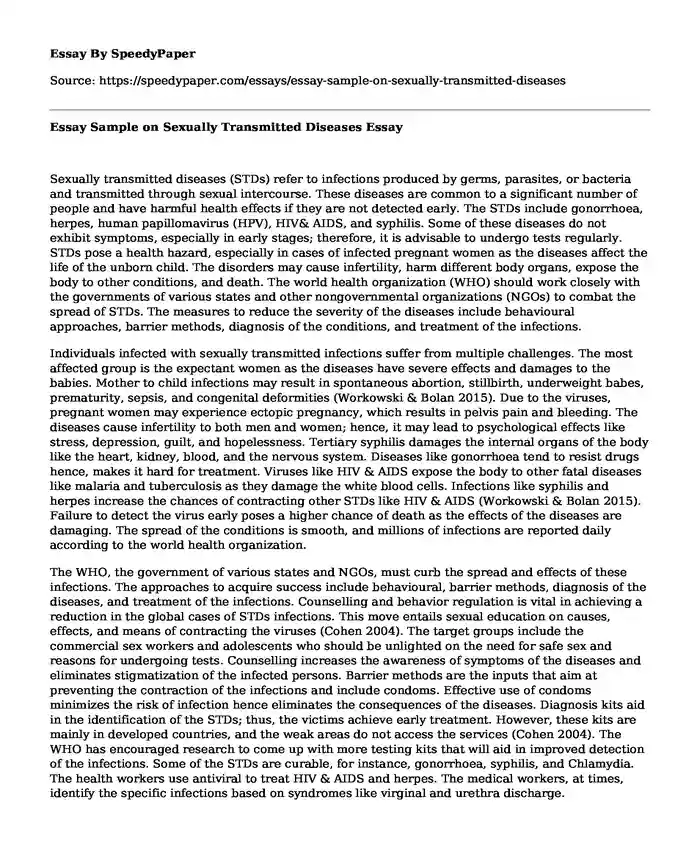
| Type of paper: | Essay |
| Categories: | Healthcare |
| Pages: | 3 |
| Wordcount: | 664 words |
Sexually transmitted diseases (STDs) refer to infections produced by germs, parasites, or bacteria and transmitted through sexual intercourse. These diseases are common to a significant number of people and have harmful health effects if they are not detected early. The STDs include gonorrhoea, herpes, human papillomavirus (HPV), HIV& AIDS, and syphilis. Some of these diseases do not exhibit symptoms, especially in early stages; therefore, it is advisable to undergo tests regularly. STDs pose a health hazard, especially in cases of infected pregnant women as the diseases affect the life of the unborn child. The disorders may cause infertility, harm different body organs, expose the body to other conditions, and death. The world health organization (WHO) should work closely with the governments of various states and other nongovernmental organizations (NGOs) to combat the spread of STDs. The measures to reduce the severity of the diseases include behavioural approaches, barrier methods, diagnosis of the conditions, and treatment of the infections.
Individuals infected with sexually transmitted infections suffer from multiple challenges. The most affected group is the expectant women as the diseases have severe effects and damages to the babies. Mother to child infections may result in spontaneous abortion, stillbirth, underweight babes, prematurity, sepsis, and congenital deformities (Workowski & Bolan 2015). Due to the viruses, pregnant women may experience ectopic pregnancy, which results in pelvis pain and bleeding. The diseases cause infertility to both men and women; hence, it may lead to psychological effects like stress, depression, guilt, and hopelessness. Tertiary syphilis damages the internal organs of the body like the heart, kidney, blood, and the nervous system. Diseases like gonorrhoea tend to resist drugs hence, makes it hard for treatment. Viruses like HIV & AIDS expose the body to other fatal diseases like malaria and tuberculosis as they damage the white blood cells. Infections like syphilis and herpes increase the chances of contracting other STDs like HIV & AIDS (Workowski & Bolan 2015). Failure to detect the virus early poses a higher chance of death as the effects of the diseases are damaging. The spread of the conditions is smooth, and millions of infections are reported daily according to the world health organization.
The WHO, the government of various states and NGOs, must curb the spread and effects of these infections. The approaches to acquire success include behavioural, barrier methods, diagnosis of the diseases, and treatment of the infections. Counselling and behavior regulation is vital in achieving a reduction in the global cases of STDs infections. This move entails sexual education on causes, effects, and means of contracting the viruses (Cohen 2004). The target groups include the commercial sex workers and adolescents who should be unlighted on the need for safe sex and reasons for undergoing tests. Counselling increases the awareness of symptoms of the diseases and eliminates stigmatization of the infected persons. Barrier methods are the inputs that aim at preventing the contraction of the infections and include condoms. Effective use of condoms minimizes the risk of infection hence eliminates the consequences of the diseases. Diagnosis kits aid in the identification of the STDs; thus, the victims achieve early treatment. However, these kits are mainly in developed countries, and the weak areas do not access the services (Cohen 2004). The WHO has encouraged research to come up with more testing kits that will aid in improved detection of the infections. Some of the STDs are curable, for instance, gonorrhoea, syphilis, and Chlamydia. The health workers use antiviral to treat HIV & AIDS and herpes. The medical workers, at times, identify the specific infections based on syndromes like virginal and urethra discharge.
References
Cohen, M. S. (2004). HIV and sexually transmitted diseases: lethal synergy. Topics in HIV medicine: a publication of the international AIDS society, USA, 12(4), 104-107. Retrieved from https://europepmc.org/abstract/med/15516707
Workowski, K. A., & Bolan, G. A. (2015). Sexually transmitted diseases treatment guidelines, 2015. MMWR. Recommendations and reports: Morbidity and mortality weekly report. Recommendations and reports, 64(RR-03), 1. Retrieved from https://www.ncbi.nlm.nih.gov/pmc/articles/PMC5885289/
Cite this page
Essay Sample on Sexually Transmitted Diseases. (2023, Jun 01). Retrieved from https://speedypaper.com/essays/essay-sample-on-sexually-transmitted-diseases
Request Removal
If you are the original author of this essay and no longer wish to have it published on the SpeedyPaper website, please click below to request its removal:
- Essay Example: Adoption versus Abortion
- Free Essay: Clinical Manifestations and Pharmacotherapy Associated with Diabetes
- Difference Between Quality Improvement Project and Research
- Free Essay: How Social Media Contribute to Anxiety and Depression
- Sampling Method and Study Design - Free Essay
- Paper Sample on Research Needs
- Mental health, Psychiatric Illness, Prevalence rate, Age, Violence, Incidences, Resources - Report Example
Popular categories




